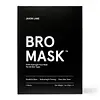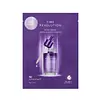What's inside
What's inside
 Key Ingredients
Key Ingredients

 Benefits
Benefits

 Concerns
Concerns

 Ingredients Side-by-side
Ingredients Side-by-side

Water
Skin ConditioningGlycerin
HumectantMethylpropanediol
SolventNiacinamide
SmoothingCeratonia Siliqua Gum
EmollientChondrus Crispus Extract
Skin ConditioningButylene Glycol
HumectantCellulose Gum
Emulsion StabilisingDipropylene Glycol
HumectantHydroxyacetophenone
Antioxidant1,2-Hexanediol
Skin ConditioningCaprylyl Glycol
EmollientSodium Polyacrylate
AbsorbentZingiber Officinale Root Extract
MaskingDisodium EDTA
Polyglyceryl-10 Laurate
Skin ConditioningXanthan Gum
EmulsifyingHydrogenated Polydecene
EmollientAdenosine
Skin ConditioningEthylhexylglycerin
Skin ConditioningPotassium Chloride
Sodium Hyaluronate
HumectantSodium Citrate
BufferingCitric Acid
BufferingDextrin
AbsorbentTrideceth-6
EmulsifyingCamellia Sinensis Leaf Extract
AntimicrobialCoptis Japonica Root Extract
Skin ConditioningDipotassium Glycyrrhizate
HumectantSchisandra Chinensis Fruit Extract
Skin ConditioningHydrolyzed Collagen
EmollientTocopherol
AntioxidantCopper Tripeptide-1
Skin ConditioningDipeptide-2
Skin ConditioningOligopeptide-1
Skin ConditioningPalmitoyl Pentapeptide-4
Skin ConditioningTripeptide-1
Skin ConditioningWater, Glycerin, Methylpropanediol, Niacinamide, Ceratonia Siliqua Gum, Chondrus Crispus Extract, Butylene Glycol, Cellulose Gum, Dipropylene Glycol, Hydroxyacetophenone, 1,2-Hexanediol, Caprylyl Glycol, Sodium Polyacrylate, Zingiber Officinale Root Extract, Disodium EDTA, Polyglyceryl-10 Laurate, Xanthan Gum, Hydrogenated Polydecene, Adenosine, Ethylhexylglycerin, Potassium Chloride, Sodium Hyaluronate, Sodium Citrate, Citric Acid, Dextrin, Trideceth-6, Camellia Sinensis Leaf Extract, Coptis Japonica Root Extract, Dipotassium Glycyrrhizate, Schisandra Chinensis Fruit Extract, Hydrolyzed Collagen, Tocopherol, Copper Tripeptide-1, Dipeptide-2, Oligopeptide-1, Palmitoyl Pentapeptide-4, Tripeptide-1
Bifida Ferment Lysate
Skin ConditioningWater
Skin ConditioningButylene Glycol
HumectantGlycerin
HumectantCichorium Intybus Root Extract
MaskingTaraxacum Officinale Rhizome/Root Extract
Skin ConditioningNiacinamide
Smoothing1,2-Hexanediol
Skin ConditioningPropanediol
SolventHydroxyacetophenone
AntioxidantHydrolyzed Jojoba Esters
Skin ConditioningChlorphenesin
AntimicrobialCarbomer
Emulsion StabilisingXanthan Gum
EmulsifyingAllantoin
Skin ConditioningPanthenol
Skin ConditioningAdenosine
Skin ConditioningArginine
MaskingDipotassium Glycyrrhizate
HumectantDisodium EDTA
Polyglyceryl-10 Myristate
Skin ConditioningPolyglyceryl-10 Laurate
Skin ConditioningHydrolyzed Collagen
EmollientCitrus Aurantium Bergamia Fruit Oil
MaskingTheobroma Cacao Extract
Skin ConditioningGlyceryl Acrylate/Acrylic Acid Copolymer
HumectantBrassica Oleracea Capitata Leaf Extract
Skin ConditioningBeta Vulgaris Root Extract
Skin ConditioningVaccinium Angustifolium Fruit Extract
Skin ProtectingDaucus Carota Sativa Root Extract
Skin ConditioningSolanum Melongena Fruit Extract
Skin ConditioningPvm/Ma Copolymer
Emulsion StabilisingBifida Ferment Filtrate
Skin ConditioningBacillus Ferment
Skin ConditioningLeuconostoc/Radish Root Ferment Filtrate
AntimicrobialLactococcus Ferment Extract
Skin ConditioningLactococcus Ferment
Skin ConditioningLactobacillus Ferment Lysate
Skin ConditioningLactobacillus Ferment
Skin ConditioningLactobacillus/Soybean Ferment Extract
Skin ConditioningLactobacillus/Punica Granatum Fruit Ferment Extract
Skin ConditioningLactobacillus/Pear Juice Ferment Filtrate
Skin ConditioningDextrin
AbsorbentLimonene
PerfumingLinalool
PerfumingBifida Ferment Lysate, Water, Butylene Glycol, Glycerin, Cichorium Intybus Root Extract, Taraxacum Officinale Rhizome/Root Extract, Niacinamide, 1,2-Hexanediol, Propanediol, Hydroxyacetophenone, Hydrolyzed Jojoba Esters, Chlorphenesin, Carbomer, Xanthan Gum, Allantoin, Panthenol, Adenosine, Arginine, Dipotassium Glycyrrhizate, Disodium EDTA, Polyglyceryl-10 Myristate, Polyglyceryl-10 Laurate, Hydrolyzed Collagen, Citrus Aurantium Bergamia Fruit Oil, Theobroma Cacao Extract, Glyceryl Acrylate/Acrylic Acid Copolymer, Brassica Oleracea Capitata Leaf Extract, Beta Vulgaris Root Extract, Vaccinium Angustifolium Fruit Extract, Daucus Carota Sativa Root Extract, Solanum Melongena Fruit Extract, Pvm/Ma Copolymer, Bifida Ferment Filtrate, Bacillus Ferment, Leuconostoc/Radish Root Ferment Filtrate, Lactococcus Ferment Extract, Lactococcus Ferment, Lactobacillus Ferment Lysate, Lactobacillus Ferment, Lactobacillus/Soybean Ferment Extract, Lactobacillus/Punica Granatum Fruit Ferment Extract, Lactobacillus/Pear Juice Ferment Filtrate, Dextrin, Limonene, Linalool
Ingredients Explained
These ingredients are found in both products.
Ingredients higher up in an ingredient list are typically present in a larger amount.
1,2-Hexanediol is a synthetic liquid and another multi-functional powerhouse.
It is a:
- Humectant, drawing moisture into the skin
- Emollient, helping to soften skin
- Solvent, dispersing and stabilizing formulas
- Preservative booster, enhancing the antimicrobial activity of other preservatives
Adenosine is in every living organism. It is one of four components in nucleic acids that helps store our DNA.
Adenosine has many benefits when used. These benefits include hydrating the skin, smoothing skin, and reducing wrinkles. Once applied, adenosine increases collagen production. It also helps with improving firmness and tissue repair.
Studies have found adenosine may also help with wound healing.
In skincare products, Adenosine is usually derived from yeast.
Learn more about AdenosineButylene Glycol (or BG) is used within cosmetic products for a few different reasons:
Overall, Butylene Glycol is a safe and well-rounded ingredient that works well with other ingredients.
Though this ingredient works well with most skin types, some people with sensitive skin may experience a reaction such as allergic rashes, closed comedones, or itchiness.
Learn more about Butylene GlycolDextrin is used to thicken a product and helps bind ingredients together. It is created from starch and glycogen.
As an emulsifier, dextrin prevents ingredients from separating. This helps elongate a product's shelf life.
Studies show coating UV filters with dextrin prevents these ingredients from being absorbed. This helps UV ingredients last longer on the skin.
Learn more about DextrinDipotassium Glycyrrhizate comes from licorice root.
Extracts of licorice have demonstrated to have antibacterial, anti‐inflammatory, antiviral, antioxidant properties.
One component, glabridin, has extra potent antioxidant and soothing properties. It has also been found to block pigmentation from UVB rays in guinea pigs.
Licorice Root also contains a flavonoid. Flavonoids are a natural substance from in plants. Flavonoids also have antioxidant properties.
Another component, glycyrrhizin, has been found to have anti-inflammatory and antimicrobial benefits. This may make licorice root extract effective at treating acne. However, more research is needed to support this.
Liquiritin is one of the flavone compounds found in licorice. It has been found to help lighten skin by preventing tyrosinase from reacting with tyrosine. When the two react, protein is converted to melanin. Melanin is the substance in your body that gives your features pigmentation.
Licorice root is native to Southern Europe and Asia. It has been used in traditional Chinese medicine to help with respiratory issues.
Learn more about Dipotassium GlycyrrhizateDisodium EDTA plays a role in making products more stable by aiding other preservatives.
It is a chelating agent, meaning it neutralizes metal ions that may be found in a product.
Disodium EDTA is a salt of edetic acid and is found to be safe in cosmetic ingredients.
Learn more about Disodium EDTAGlycerin is already naturally found in your skin. It helps moisturize and protect your skin.
A study from 2016 found glycerin to be more effective as a humectant than AHAs and hyaluronic acid.
As a humectant, it helps the skin stay hydrated by pulling moisture to your skin. The low molecular weight of glycerin allows it to pull moisture into the deeper layers of your skin.
Hydrated skin improves your skin barrier; Your skin barrier helps protect against irritants and bacteria.
Glycerin has also been found to have antimicrobial and antiviral properties. Due to these properties, glycerin is often used in wound and burn treatments.
In cosmetics, glycerin is usually derived from plants such as soybean or palm. However, it can also be sourced from animals, such as tallow or animal fat.
This ingredient is organic, colorless, odorless, and non-toxic.
Glycerin is the name for this ingredient in American English. British English uses Glycerol/Glycerine.
Learn more about GlycerinHydrolyzed collagen has a misleading name because it is actually a mixture of various proteins/peptides. This ingredient has skin hydrating properties.
Collagen is the most abundant type of structural protein found in your body. In your skin, it is responsible for keeping it firm and youthful.
Hydrolyzed Collagen is created by breaking up proteins into smaller peptide bonds. These peptides act as humectants and emollients.
Humectants are great at holding onto water, keeping skin hydrated. Emollients create a thin barrier on the skin to prevent moisture from escaping.
There is ongoing debate about whether hydrolyzed collagen works because it increases skin hydration. Skin hydration is also linked to elasticity and the appearance of wrinkles.
Collagen or peptide ingredients can be used in the morning or night. They will not increase sun sensitivity, but you should always wear sunscreen during the day.
According to a manufacturer, this ingredient is a great hair conditioner as well.
This ingredient can be extracted from different sources, including:
Vegan collagen is derived from yeast, bacteria, or plant sources. Vegan collagen would go by a different INCI name, such as hydrolyzed soy protein.
The results are varied.
A study from 2021 found hydrolyzed collagen increased elasticity and improved wrinkles in 1,125 participants between age 20 and 70. Another study found increased skin thickness in participants between the ages of 45 to 59.
However, It is difficult to prove that oral collagen will end up working on your skin. Many of the studies using hydrolyzed collagen also add several vitamins and nutrients into the test mixture as well.
Further studies are needed at this time.
Learn more about Hydrolyzed CollagenHydroxyacetophenone is antioxidant with skin conditioning and soothing properties. It also boosts the efficiency of preservatives.
This ingredient is not irritating or sensitizing.
Niacinamide is a multitasking form of vitamin B3 that strengthens the skin barrier, reduces pores and dark spots, regulates oil, and improves signs of aging.
And the best part? It's gentle and well-tolerated by most skin types, including sensitive and reactive skin.
You might have heard of "niacin flush", or the reddening of skin that causes itchiness. Niacinamide has not been found to cause this.
In very rare cases, some individuals may not be able to tolerate niacinamide at all or experience an allergic reaction to it.
If you are experiencing flaking, irritation, and dryness with this ingredient, be sure to double check all your products as this ingredient can be found in all categories of skincare.
When incorporating niacinamide into your routine, look out for concentration amounts. Typically, 5% niacinamide provides benefits such as fading dark spots. However, if you have sensitive skin, it is better to begin with a smaller concentration.
When you apply niacinamide to your skin, your body converts it into nicotinamide adenine dinucleotide (NAD). NAD is an essential coenzyme that is already found in your cells as "fuel" and powers countless biological processes.
In your skin, NAD helps repair cell damage, produce new healthy cells, support collagen production, strengthen the skin barrier, and fight environmental stressors (like UV and pollution).
Our natural NAD levels start to decline with age, leading to slower skin repair, visible aging, and a weaker skin barrier. By providing your skin niacinamide, you're recharging your skin's NAD levels. This leads to stronger, healthier, and younger looking skin.
Another name for vitamin B3 is nicotinamide. This vitamin is water-soluble and our bodies don't store it. We obtain Vitamin B3 from either food or skincare. Meat, fish, wheat, yeast, and leafy greens contain vitamin B3.
The type of niacinamide used in skincare is synthetically created.
Learn more about NiacinamidePolyglyceryl-10 Laurate is an ester of lauric acid and Polyglycerin-10.
Polyglyceryl-10 Laurate is a cleansing agent and emulsifier. It helps gather dirt, oil, and other pollutants to be rinsed away. As an emulsifier, it helps prevent ingredients from separating, such as oil and water.
Polyglyceryl-10 Laurate may not be fungal acne safe.
Learn more about Polyglyceryl-10 LaurateWater. It's the most common cosmetic ingredient of all. You'll usually see it at the top of ingredient lists, meaning that it makes up the largest part of the product.
So why is it so popular? Water most often acts as a solvent - this means that it helps dissolve other ingredients into the formulation.
You'll also recognize water as that liquid we all need to stay alive. If you see this, drink a glass of water. Stay hydrated!
Learn more about WaterXanthan gum is used as a stabilizer and thickener within cosmetic products. It helps give products a sticky, thick feeling - preventing them from being too runny.
On the technical side of things, xanthan gum is a polysaccharide - a combination consisting of multiple sugar molecules bonded together.
Xanthan gum is a pretty common and great ingredient. It is a natural, non-toxic, non-irritating ingredient that is also commonly used in food products.
Learn more about Xanthan Gum